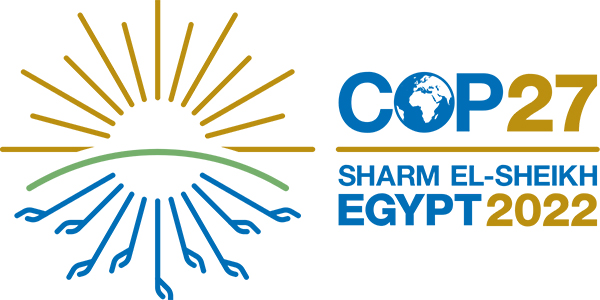
By Judith Diment, Dean, Rotary Representatives Network to the UN and International Agencies

I was delighted to have the chance to lead the Rotary delegation to the United Nations Convention on Climate Change, COP27, in Egypt in November. It’s a privilege that came my way as dean of the Rotary Representative Network to the United Nations and International Agencies. The worldwide climate change conference is held every year by the UN, this year attended by more than 100 country delegations and 1,600 IGOs and NGOs. After 13 days of intense negotiations, the attendees reached some truly consequential agreements. It was a real thrill to see.
Rotary’s delegation to the convention also consisted of President Jennifer Jones; Dr. Chris Puttock, co-founder of the Environmental Sustainability Rotary Action Group (ESRAG); Mohamed Delawar, Rotary’s representative to the Arab League; and Keith Madden, the Rotary staff manager for environment. Rotary has had Observer status in the UN since its formation in 1947.
The conference was hosted by the Egyptian Government in Sharm el Sheikh, a city on the southern tip of the Sinai Peninsula. I last visited Sharm el Sheikh in 2006, and I didn’t recognize the new conference center, expanded airport, and five-star resort hotels that have sprung up all along the edge of the Red Sea. The town has also been revamped, with a huge new mosque at its center.
Opening ceremony
President Jones attended the opening ceremony on 7 November, one of 30 NGO delegates invited to do so out of 10,000 at the conference. I attended the keynote address by U.S. President Joe Biden on 13 November. Rotary also hosted three gatherings and participated in events for delegates and the public.
The conference concluded with a breakthrough accord on 19 November. Every party present – representing almost 200 nations – signed on to an agreement to provide “loss and damage” funding for vulnerable countries hit hard by climate disasters.
The conference’s achievements didn’t end there. Against a difficult geopolitical backdrop, the participants reaffirmed their commitment to limiting global temperature rise to 1.5 degrees Celsius above pre-industrial levels. The participants also agreed to ramp up their efforts to cut greenhouse gas emissions and increase their support for efforts of developing countries to adapt to the inevitable impacts of climate change.
But the creation of the specific “loss and damage” fund was a particularly important achievement, since it was the first time such a measure had been adopted.
As inspiring as those results were, I was almost as excited about what we managed to achieve on behalf of Rotary.
Protecting mangroves and other measures
Working with the Rotarians from Egypt, we highlighted Rotary’s mangrove forest restoration projects at two events. The first event, Nature-Based Solutions: Mangroves and Beyond, built on the round-table discussions Rotary held on mangroves at last year’s climate conference. This meeting gave us new connections for the mangrove projects as well as ideas for next year’s conference, which will be held in the United Arab Emirates.
The second event, Nature-Based Solutions: Egypt included high-level government officials and delegates from NGOs and academia. The Egyptian delegation showed a video outlining a dozen nature-based solutions from clubs around Egypt. Our Rotary delegation presented the mangrove projects, ESRAG and the need to collect data. Reem Abdel Meguid and Jones announced a new Sharm el-Sheikh global grant of more than $100,000 for a Nabq mangroves project. It really showed how Rotary’s “People of Action” can get things done in hours and days!
The evening presidential reception, with Jones as host, was attended by more than 60 delegates, including the governor of South Sinai, representatives from many federal governments, and local dignitaries, along with three Egyptian government ministers: Minister of Culture Nivine Youssef Mohamed Al-Kilany, Minister of Youth Ashraf Sobhy, and Minister for Social Solidarity Nivine El-Kabbag. El-Kabbag announced in her speech that she would have her agency donate $50,000 to the Nabq mangrove project.
I also attended many other side events and had one-on-one meetings with many civil society leaders and government representatives. I was impressed by the progress since last year’s conference, especially with the amount of new research, innovation, and investments made to try and find solutions for climate change.
Learn more about how Rotary is protecting our environment. Is your club involved in a project to protect the environment? Tell us about it in the comments section below.
https://blog.rotary.org/2023/01/05/rotary-delegates-attend-climate-change-conference/
